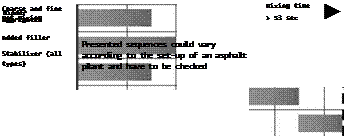Sequence of Mixing Constituents in a Batch Asphalt Plant
Establishing the sequence of putting materials into the pugmill is chiefly aimed at securing the final homogeneity of a mixture. Mixing constituents consists of the following two stages:
• Dry mixing—this starts the moment the aggregate is deposited into the pugmill, and it ends the moment the binder batching starts.
• Wet mixing—this starts the moment the binder batching begins, and it ends the moment the mixture is discharged into a trolley delivering hot material to a silo (the pugmill’s opening).
With regards to the aforementioned stages of mixing, the following universal principles are well-known: [57]
 |
0 10 20 30 40 50 60
Seconds
FIGURE 9.2 The batching sequence in a batch-type asphalt plant according to German DAV handbook. (From Druschner, L. and Schafer, V., Splittmastixasphalt. DAV Leitfaden. Deutscher Asphaltverband, 2000. With permission.)
According to the German DAV handbook [Druschner and Schaffer, 2000], the batching sequence does not depend on the kind of stabilizer. There is an assumption in the DAV handbook that the total mixing time of a cycle should be longer than 53 seconds and consist of the actions shown in Figure 9.2. However, depending on the form of stabilizer (loose fibers or granules), various batching patterns have been cited in other publications, including German ones (Graf, 2006; Schunemann, 2007). These cases are discussed in Sections 9.3.3.1 and 9.3.3.2.
Aside from the universal procedure according to the DAV handbook, there are various batching patterns, depending on the form of stabilizer (loose or granulated fibers), established and practiced by many producers of SMA mixtures.






Leave a reply